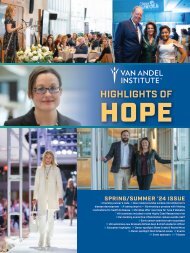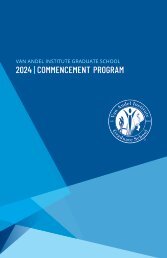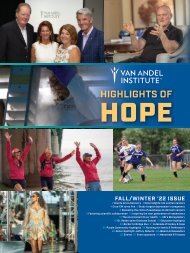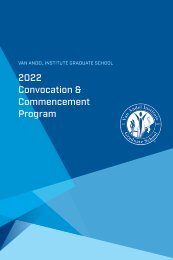2017 Annual Report
You also want an ePaper? Increase the reach of your titles
YUMPU automatically turns print PDFs into web optimized ePapers that Google loves.
RESEARCH<br />
attack the disease from a new direction.”<br />
Here again, the nose may harbor important clues. Fueled<br />
by a set of new Department of Defense grants totaling<br />
$4.37 million, Dr. Patrik Brundin and collaborators at<br />
University of Southern California and Michigan State<br />
University are investigating the role of air pollution as a<br />
potential contributing factor to Parkinson’s. Their theory?<br />
That environmental factors such as pollution build on<br />
a person’s specific genetic influences and age — the<br />
single greatest risk factor for Parkinson’s — setting off an<br />
uncontrolled inflammatory chain reaction.<br />
Bringing it together<br />
In all, Parkinson’s is likely the result of a complex mix of<br />
genetics, epigenetics and environmental triggers that<br />
set a cascade of problems into motion. Some cause the<br />
abnormal clumping of alpha-synuclein, turning it from a<br />
harmless protein into a toxic one, while others bog down<br />
cellular machinery, interfering with processes designed to<br />
keep cells healthy. Genetic and epigenetic factors almost<br />
certainly are at play as well, influencing individuals’ risk of<br />
developing the disease. Each newly identified contributing<br />
factor reveals a chink in the armor of Parkinson’s, ripe for<br />
targeting by new or repurposed medications.<br />
“We’ve come a long way since James Parkinson put ink to<br />
paper, from viewing the disease as a one-size-fits-all motor<br />
disorder to our current understanding of Parkinson’s as a<br />
diverse multi-system event,” Dr. Patrik Brundin said.<br />
“Together with collaborators around the world, our<br />
scientists are pushing forward quickly. We’re on the edge<br />
of ushering in a monumental change in how Parkinson’s<br />
patients are diagnosed and treated. I’m more excited —<br />
and hopeful — now than ever before.”<br />
(LEFT TO RIGHT) DR. VIVIANE LABRIE, DR. LENA BRUNDIN & DR. PATRIK BRUNDIN.<br />
VAN ANDEL INSTITUTE ANNUAL REPORT <strong>2017</strong> | 7

















